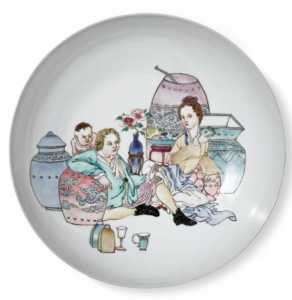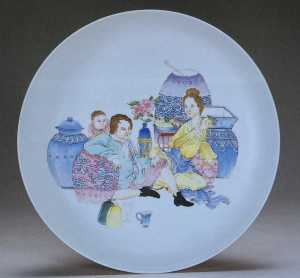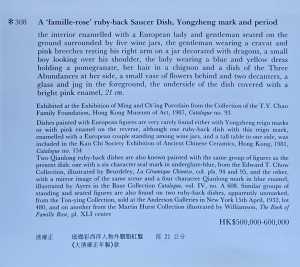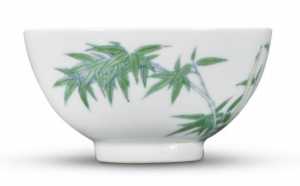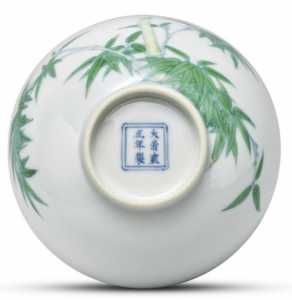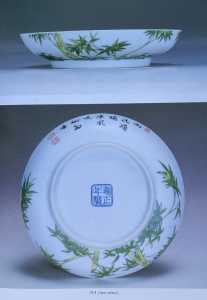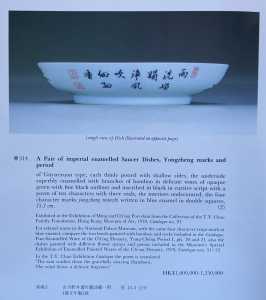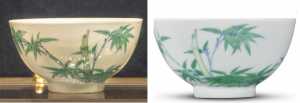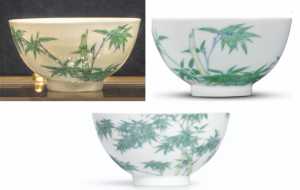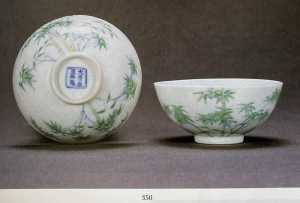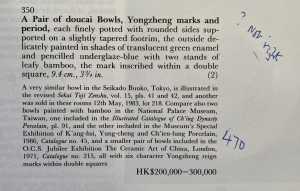The Chinese and Asian Art Forum. For Fans, Collectors and Dealers.
 Basic Rules For the BidAmount Asian Art Forum: Talk about whatever you want. You can even discuss and offer things that are for sale if they are authentic. Maximum image file size per post is 2 MB. Images of 700pxl x 700pxl are optimal if saved at a medium resolution. Be respectful of others and enjoy yourself. Click the YouTube link for a brief tutorial on using the forum. You can also EMBED Videos by cutting and pasting from You-Tube, Vimeo etc.
Basic Rules For the BidAmount Asian Art Forum: Talk about whatever you want. You can even discuss and offer things that are for sale if they are authentic. Maximum image file size per post is 2 MB. Images of 700pxl x 700pxl are optimal if saved at a medium resolution. Be respectful of others and enjoy yourself. Click the YouTube link for a brief tutorial on using the forum. You can also EMBED Videos by cutting and pasting from You-Tube, Vimeo etc.
NOTE: To post an item or add a new post, click open the category title from the FORUM LIST, and CLICK the Blue ADD TOPIC button.
@xin_fawis @greeno107 @clayandbrush
Dear Xin, Tim, Giovanni and all ...
A very interesting and thought provoking thread ...
I attached the following images for comparison ...
The first is the Sotheby’s European dish, and next is the image/description of an identical Yongzheng dish, ex T.Y. Chao Coll, sold Lot 308, Sbys HK 19 May 1987, single owner sale ...
Even allowing for slight differences in painting styles by different artists, when you look at the T.Y. Chao example and the Sotheby’s piece just sold, they are polls apart - just compare the faces, details in the clothes folds, or shading of the enamels ...
The second is the Sotheby’s bamboo bowl, and next are images/description of a pair of Yongzheng dishes, again ex T.Y. Chao Coll, sold Lot 314 at the same Sby’s HK 19 May 1987 single owner sale ...
Again, compare/note the differences in overall drawing, the detailing of the leaves, the shading used to emphasis the nodes on the branches or the differing tones of the leaves on the T.Y. Chao examples are far superior that seen on the bowl ...
I have posted these just to show the differences in painting styles, detailing and enamel tones ...
As always even the best images are subjective, one would have to see, handle, examine closely and have an in-depth knowledge of Imperial Yongzheng porcelains before any conclusion could be teach however, personally I think Sotheby’s called these pieces right ...
I would also concur with the points raised by Giovanni - there are always ‘games been played’, within the major auction houses ...
Stuart
This pair of Yongzheng cups are in the collection of Nanjing Museum, China. There are many designs which you don't know.
www.Wyssemaria-Art.com
[email protected]
Instagram: @wyssemaria_art
There is a Yongzheng mark and period dish with a similar composition sold at Sotheby's in 1987? It would be interesting to see the back of that one. To see if the calligraphic style of the mark matches. I thought it was interesting that the style of the marks matches for the plates at the museum and the plate now sold at Sothebys. Thanks for making that comparison, Xin.
@xin_fawis Xin, thank you for posting the Nanjing Museum photos.
Let's put the bowls side by side.
When comparing to the Sotheby's bowl, you can see that the NJ Museum bowls seem to have a a much thicker application of green enamel, and much darker line work, but the design is an exact match.
Honestly, side by side, the Sotheby's example looks to be a much closer to the true style of doucai work than the museum example you've posted. Perhaps some of that is due to the lighting in the photography, but that museum piece looks very odd in the almost black line work and reflective glaze.
My limited experience with doucai has taught me that the greens are so subdued that they blend into the underglaze blue line work in a manner that creates great depth, and a uniquely sublime and ghostly irridescence. The NJ Museum piece doesn't seem to have any of that.
Not to widen the idea of conspiracy, but what is the source/provenance of the NJ Museum bowls? As I've mentioned earlier, fakes are entering into museums.
Here is a a three way comparison of the two above bowls, plus another Sotheby's 'bamboo' cup that sold in 2014 (I'll post the link after my comparison photo).
This year especially, we've entered into a global culture of distrust and conspiracy, to the point that I find myself asking on a regular basis, should I believe my lying eyes or shouldn't I? Perhaps a part of my skepticism is driven by current events, but even as a non-scholar, let me say that there clearly are differences in all three bowls.... big differences that prevent me from consenting to any assessment of authenticity.
It is far too easy to rely on our person feelings (our 'gut decision') to make the final call, and I suggest we rely on the time tested precedent that has served the collecting world for generations, and we should error on the side of conservative restraint by rejecting what is 'new' without absolute unanimous consent about the authenticity of any piece.
@greeno107 I agree with you to a degree, but when you get into the absolute unanimous business, I think you set the bar too high, because too many times experts disagree these days. If nine of them say yes but one says no, should the whole world then adhere to the opinion of the lone no voice? I don't think that makes any practical sense. But, if you get a majority of those experts to sign off, that much would be a reasonable approach to assessing these things in my view. Also, without handling these trickier high level pieces in person, our understanding is going to be limited. Whoever is making the final decisions about these things should be doing so in person. None of us here who have not handled these pieces should be so certain about our opinion of these objects.
@johnshoe I think the way you have characterized it is not exactly what I mean by the process of unanimous agreement, but I understand what you are saying. I over simplified my response.
To clarify, if there was one person who decents, and provides some verifiable explination as to why they decent, not just some speculative assumption, AND their objection can not be disqualified, then that one objection is sufficient to disqualify a piece as genuine.
For example, IF I were to say that the color of the underglaze blue in the Sotheby's bowl was incorrect to be genuine Yongzheng, and 9 other experts say it is correct and are able to point to known Yongzheng examples, THEN my objection would not be sufficient and I should withdraw my objection.
However, IF I were to say that the color of the underglaze blue in the Sotheby's bowl was incorrect to be genuine Yongzheng, and 9 other experts are unable to point to known Yongzheng examples that disproves my objection, THEN my objection is warranted, and the piece in question should be considered potentially of a later period.
I'm not in a position to make any firm determination on the basis of photos that this piece is absolutely a later copy, but there is sufficient visual clues to be very concerned about the quality of the rendering that seems to contradict what we know about Yongzheng doucai works. And because of these concerns, I think Sotheby's made a very sound decision calling the piece 20th c.
Hi Xin, Tim and all,
Again, just for comparison and discussion ...
A pair of doucai bowls, described as Yongzheng m/p, sold Lot 350, Sby’s HK 16 November 1988 ...
These examples show the bamboo design rendered in a different composition then the other examples posted ...
The inked remark reading ‘? Not right’ was written by my first teacher who was, at the time of this sale, a member of the prestigious Min Chiu Society and had been head of the acquisitions committee for the, then, HK City Hall Museum since the mid 1970’s ...
So yes, there are several different bamboo designs known but, as the above probably indicates, even by the late 80’s, some of these were been questioned as to there authenticity ...
Tim raises a valid, and well known, point in stating that fakes have, and unfortunately still are, entering Institutions and Museums ...
Stuart
The Nanjing Museum is a national museum. Their collections are mainly from the imperial palace inventory and archaeological finds. In general, they do not accept private donations. The national and provincial museums are very careful about donations. Not like museums of other countries, their collections are mainly from donations.
By the way, these Yongzheng cups in Nanjing museum are from the imperial inventory.
I have studied archives of the Qing Palace Office of Internal Affairs - Manufacturing Office for a while. Examples are made and offered to the emperor Yongzheng. He was involved in the design process, even in details. Quote: "Too much leaves" or "Too much colour". Comments like this are documented very often. So we can see many different designs or developments of designs during his reign.
The research is still ongoing. There is always something new to learn. Edward T. Chow also made mistakes.
www.Wyssemaria-Art.com
[email protected]
Instagram: @wyssemaria_art
https://www.christies.com/lot/lot-5953603
Story about this bowl.
This bowl was owned by Donald Bonney and Paul Freeman. Veteran British dealer Gerard Hawthorn said he bought the enamel bowl for £3 at an antique store on Kensington Church Street in the early 1970s, then sold it for £9 to his colleague Donald Bonney, who worked with him at Sydney Moss's store, and in 1986 Mr. Bonney transferred it to the next owner Paul Freeman. He said it was thought to be a Republican copy at the time, and it sold for HK$75 million at Christie's Hong Kong today. Before the auction at Christie's, Freeman offered this bowl to Eskenazi, Marchant, Sotheby's and other major dealers. None of them accepted it as being from the Yongzheng period. Christie's took this bowl and brought it to Taiwan to compare it with other Falangcai bowls from the Palace Museum in Taipei. They found that it was indeed a Yongzheng bowl.
www.Wyssemaria-Art.com
[email protected]
Instagram: @wyssemaria_art
Looks like we've got a winner ...
There is no winner or loser. We are still studying and discussing. 😉
www.Wyssemaria-Art.com
[email protected]
Instagram: @wyssemaria_art
Dear Xin,
it is not clear if you believe that the falangcai sepia enameled bowl sold by christie’s is a genuine one that has not been recognized as such by the other dealers, or if you think that Christie’s did a mistake.
I can’t say if it is genuine or not, and nobody on Earth could say that with certainty, based on one picture only. But I would stay with a rule that has proven valid too many times: if they had to bring it to Taipei to compare it with a genuine example, then most probably is not Yongzheng.
The real thing is always evident at first glance to expert’s eyes. In this case, it is also proven by the fact that all the other ones didn’t think that it was genuine.
Regards,
Giovanni
Oh, my god! So now the sepia-enamelled bowl at Christie's is fake too?
Thanks for visiting "The BidAmount Asian Art Forum | Chinese Art"
If you sell on eBay, or have a shop feel free to post images and descriptions and links.
Check back often for discussion about the latest news in the Chinese art and antique world. Also find out about the latest Asian art auctions at Sotheby's, Christie's, Bonhams and Tajans.
Auction results for: fine porcelain, ceramics, bronze, jade, textiles and scholar's objects. As well as Japanese, Thai, Vietnamese and other Asian cultures.
Thank you,
Peter Combs
Topics and categories on The BidAmount Asian Art Forum | Chinese Art
Kangxi vases, Kangxi dishes and chargers, Kangxi ritual pieces, Kangxi scholar's objects, Qianlong famille rose, Qianlong enamels, Qianlong period paintings, Qianlong Emporer's court, Fine porcelain of the Yongzheng period. Chinese imperial art, Ming porcelain including Jiajing, Wanli, Xuande, Chenghua as well as Ming jades and bronzes.
The BidAmount Asian Art Forum | Chinese Art
A free Asian art discussion board and Asian art message board for dealers and collectors of art and antiques from China, Japan, Korea, Thailand, Cambodia, Vietnam and the rest of Asia. Linked to all of the BidAmount Asian art reference areas, with videos from plcombs Asian Art and Bidamount on YouTube. Sign up also for the weekly BidAmount newsletter and catalogs of active eBay listing of Chinese porcelain, bronze, jades, robes, and paintings.
The art of calligraphy - and for the ancient Chinese it certainly was an art - aimed to demonstrate superior control and skill using brush and ink. Calligraphy established itself as one of the major Chinese art forms during the Han dynasty (206 BCE - 220 CE), and for two millennia after, all educated men were expected to be proficient at it.
The Museum’s collections of Asian art span nearly five millennia and encompass the cultures of China, the Himalayas, India, Japan, Korea, and Southeast Asia. In 2007, the Museum launched an initiative to create dedicated galleries for the collection, beginning with a gallery for the arts of Korea ...
Chinese art is full of symbolism, in that artists typically seek to depict some aspect of a totality of which they are intuitively aware.
China Online Museum is the finest online museum of Chinese art. It features Chinese calligraphy, painting, ceramics, bronzes, carving, and other artworks.
Chinese Ceramics & Works of Art. Overview Upcoming auctions Contacts Auction results ... Christie’s sales of Chinese ceramics and works of art showcase centuries of Chinese history. Held throughout the year in London, New York, Paris and Hong Kong, they attract a wide audience of collectors and connoisseurs vying for pieces as diverse as ...
Explore Asian Art Week. Contact the Specialist Department. Chinese Paintings ... Senior Specialist, Head of Sale. [email protected]. Tel:+1 212 641 5760. Bid in-person or online for the upcoming auction:Fine Chinese Paintings on 10 September 2019 at New York. Bid in-person or online for the upcoming auction:Fine Chinese Paintings on 10 ...
Discover an abundance of must-see art from all corners of a vast continent at Christie’s NY Asian Art Week. From contemporary classical and Chinese paintings to works with exemplary provenance from the Art Institute of Chicago, our Rockefeller Paza galleries will be full of ancient treasures and contemporary masterworks in a salute to the vibrant arts of Asia.
Sold to benefit The Art Institute of Chicago’s Asian Art Acquisition Fund, the sale features 84 lots with a focus on Ming and Qing porcelains, and offers a rare insight into the taste for collecting Chinese ceramics and works of art in the Midwest from the end of the 19th century through the 1980s. Highlights include two Wanli wucai garlic-head vases, a Qianlong mark and period, blue and ...
Specialist, Chinese Paintings, Christie's London Dr Malcolm McNeill is a Specialist in Chinese Paintings at Christie’s, based in London. He previously worked as an assistant curator of the Chinese collections and the Victoria and Albert Museum in London, as a researcher at the British Museum, and as a translator and tour guide at the National Palace Museum in Taipei.
The Christie's Education 2020 Conference: The Chinese Art Market 18 Jun 2019 Christie’s Education is delighted to announce our first international academic conference in Asia which will take place in Hong Kong from 26-27 November 2020 at the Hong Kong Convention and Exhibition Centre and will run in parallel with Christie’s Hong Kong Autumn Auctions.
The summer Chinese Art sale in Hong Kong will feature works of art from several private collections, including Qing porcelains and textile from the collection of the legendary Chinese art dealer A. W. Bahr (1877–1959), fine gilt bronze Buddhist sculptures from an old Hong Kong collection, an East Asian collection of Qing dynasty wine cups and jades, and a Japanese collection of Song ceramics ...
Sotheby's Chinese Works of Art Department holds two auctions each year in London, New York, Hong Kong and Paris.
Chinese Art - View Auction details, bid, buy and collect the various artworks at Sothebys Art Auction House.
With more than 340 Chinese works of art dating from the Neolithic to the Republic periods, highlights of this sale include a selection of Qing Imperial monochromes from the collection of Arnold and Blema Steinberg, early ceramics from the Art Institute of Chicago and Chinese porcelain and works of art from the collection of Henry Arnhold.
Results: Sotheby's Asia Week achieved $52.4 million in six strong auctions, exceeding pre-sale estimates. With 76.5% of lots sold and 60.3% of lots surpassing high estimates, the Asian art sales at Sotheby's indicate continued collector interest in the finest works of art from China, India and and the Himalayas.
Today's sale of Important Chinese Art will proceed as planned with sessions at 10 AM and 2 PM EDT. Sotheby's will be monitoring the weather conditions throughout the day and will be available to coordinate alternative bidding options should conditions make it difficult for clients to attend the auction in person.
Bonhams Chinese Art department is renowned for offering the finest works of art representing the richness and breadth of China's artistic heritage, particularly Imperial porcelain, white and spinach green jades, cloisonné and Buddhist art. Specialised international auctions are held globally, including London, Hong Kong and San Francisco.
Bonhams : Chinese Works of Art We use cookies to remember choices you make on functionality and personal features to enhance your experience to our site. By continuing to use our site you consent to the use of cookies. Please refer to our privacy and cookie policies for more information.
Bonhams Fine Art Auctioneers & Valuers: auctioneers of art, pictures, collectables and motor cars. We use cookies to remember choices you make on functionality and personal features to enhance your experience to our site. By continuing to use our site you consent to the use of cookies. ... Chinese Art (US) General enquiries
Bonhams : Fine Chinese Art We use cookies to remember choices you make on functionality and personal features to enhance your experience to our site. By continuing to use our site you consent to the use of cookies. Please refer to our privacy and cookie policies for more information.
Bonhams Fine Art Auctioneers & Valuers: auctioneers of art, pictures, collectables and motor cars Bonhams : Asian Art We use cookies to remember choices you make on functionality and personal features to enhance your experience to our site.
Bonhams are international auctioneers of fine Chinese and Japanese art. We specialise in rare Imperial and Export Chinese ceramics and works of art, as well as Japanese ceramics, fine and decorative works of art from the Neolithic Period to the 20th century. View on map
Bonhams Fine Art Auctioneers & Valuers: auctioneers of art, pictures, collectables and motor cars. We use cookies to remember choices you make on functionality and personal features to enhance your experience to our site. By continuing to use our site you consent to the use of cookies. ... Asian Art Bonhams. Work. 22 Queen St.
